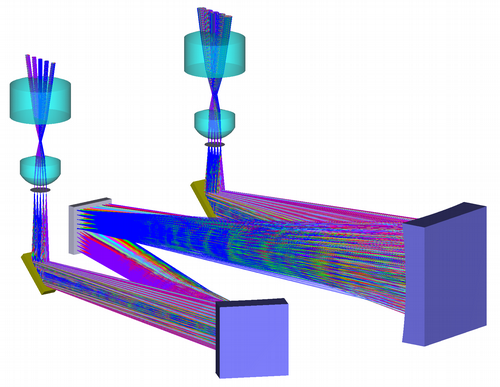Monitoring Venus cloud top: the VenSpec-U spectrometer on board ESA EnVision
- 1LATMOS/IPSL, UVSQ Université Paris-Saclay, Sorbonne Université, CNRS, Guyancourt, France (emmanuel.marcq@latmos.ipsl.fr)
- 2IRAP, Observatoire Midi-Pyrénées, Toulouse, France
- 3LESIA, Observatoire de Paris, PSL, Meudon, France
- 4BIRA, Brussels, Belgium
- 5DLR, Berlin, Germany
- 6AOPP, Oxford, United Kingdom
- 7Royal Holloway, University of London, United Kingdom
Instrument description
The VenSpec-U instrument is a dual channel UV spectral imager (low and high spectral resolution channels, “LR” and “HR” hereafter), part of the VenSpec spectrometer suite on board the proposed Venus orbiter EnVision. Each channel consists of an entrance baffle, an objective composed of two lenses and a stop diaphragm, and a spectrometer composed of a slit and a toroidal holographic grating. It also includes s shortpass filter to reject the wavelengths above the higher limit of both channel bands and a zero-order trap to avoid straylight due to internal reflexions of the grating zero-order. The optical layout is presented in Figure 1. Both LR and HR slits are parallel and the optical layout is such that both channels have the same instantaneous field of view (FoV), allowing simultaneous observations and calibrations. Each slit image is then spectrally dispersed by its respective toroidal holographic grating and is formed on a shared CMOS back-side illuminated detector.
 |
Figure 1: VenSpec-U optical layout overview, with the HR and LR channels respectively on the left and on the right. |
The narrow-slit axis of the detector contains the spectral information, whereas the long-slit axis contains the spatial information along the 22.5° FoV of each slit. The spectra of LR and HR channels are dispersed one above the other on the focal plane. The remaining spatial direction is provided through orbital scrolling (“pushbroom” strategy). Binning on the spatial axis is performed on the detector. The detector will be controlled such that the integration time and the binning scheme is adjusted independently (and simultaneously) for each channel giving high flexibility and providing parameters for the optimisation of each acquisition.
Instrument Performance
According to our forward model based on HST-STIS [Jessup et al., 2015] and SPICAV-UV heritage [Marcq et al., 2020], this shall be sufficient to measure the targeted species (SO, SO2, UV absorber) with a relative accuracy better than 25%. These measurements shall allow to characterize variability of Venus cloud top on temporal scales ranging from hours to years and spatial scales ranging from a few kilometers to planetary scale in relation to the climate and/or present day volcanic activity of Venus.
Bibliography
- K. L. Jessup et al., Coordinated Hubble Space Telescope and Venus Express Observations of Venus’ upper cloud deck, Icarus 258, 2015
- E. Marcq et al., Climatology of SO2 and UV absorber at Venus’ cloud top from SPICAV-UV nadir dataset, Icarus 335, 2020
How to cite: Marcq, E., Guignan, G., Lustrement, B., Montmessin, F., Lasue, J., Bézard, B., Vandaele, A. C., Helbert, J., Widemann, T., Wilson, C., and Ghail, R.: Monitoring Venus cloud top: the VenSpec-U spectrometer on board ESA EnVision, Europlanet Science Congress 2020, online, 21 Sep–9 Oct 2020, EPSC2020-622, https://doi.org/10.5194/epsc2020-622, 2020.

